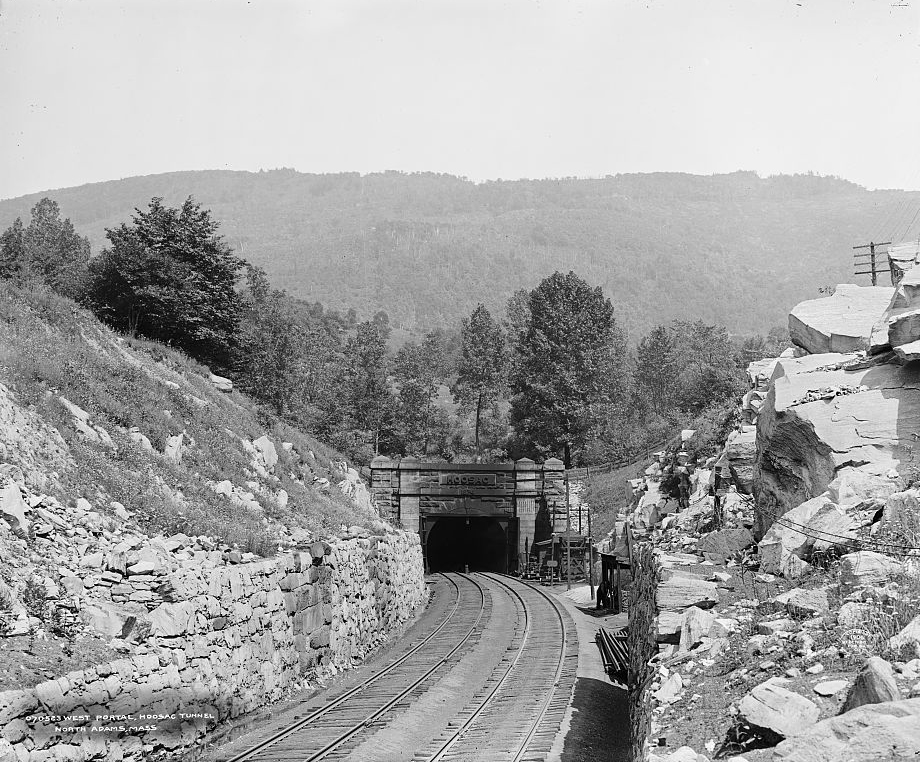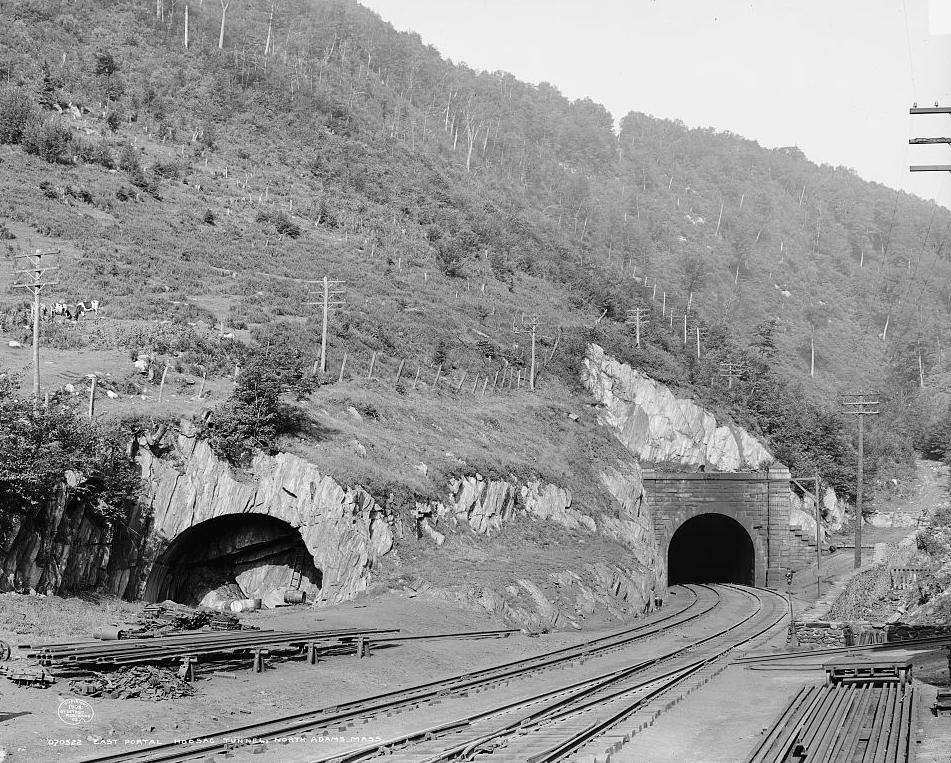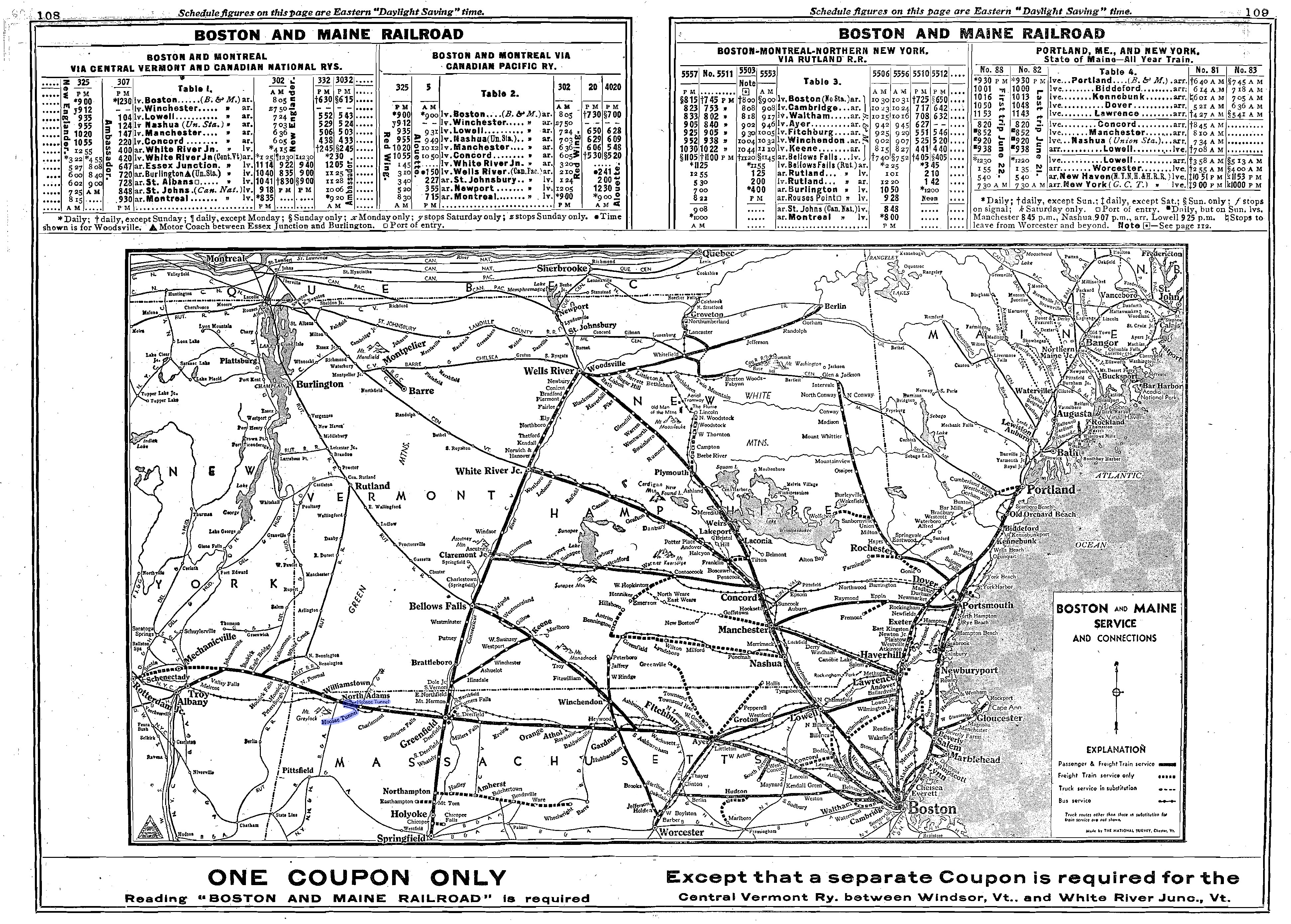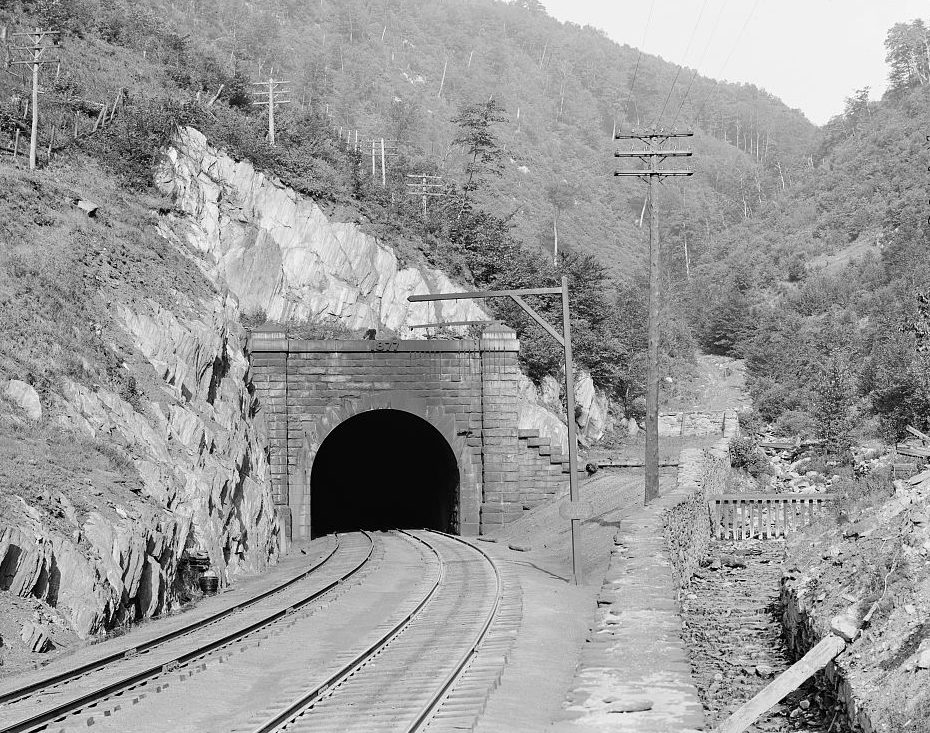Hoosac Tunnel (Massachusetts): Map, Length, Location, History
Last revised: February 27, 2025
By: Adam Burns
The Hoosac Tunnel is a 4.75-mile-long (25,081 feet) active railroad tunnel in western Massachusetts that passes through the Hoosac Range, an extension of Vermont's Green Mountains.
Apart from its length, the tunnel stands with a height of approximately 20 feet and a width of 24 feet. It's estimated to contain 25 million cubic feet of rock and was driven through gneiss, a high-grade metamorphic rock known for its hardness.
Opened in 1875, it was considered an engineering marvel of its time, being one of the longest tunnels in the world when completed.
The tunnel's construction was a massive project that took over two decades to complete, with many challenges including numerous fatalities and financial difficulties. Today, it is still in use and is an important transportation link in the region.
The construction involved a staggering amount of manual labor and a few mechanical excavators. Workers used a combination of black powder, nitroglycerine, and later dynamite for blasting through the sturdy gneiss rock.
Construction originally began in 1851. However, due to several technical setbacks and funding challenges, the completion was delayed. After perseverance and toiling, the tunnel was eventually opened to rail traffic by February 9, 1875.
Hoosac's west portal is located at the town of North Adams while the east portal is located at the community of Florida along the Deerfield River.
In its current state, the tunnel is still in operation and forms part of the Pan Am Southern route, a collaboration between what is now the Berkshire & Eastern and Norfolk Southern Railway. Initially, the Boston and Maine was the main operator after acquiring the Troy and Greenfield Railroad.
Overview
While the Hoosac Tunnel is often identified as being a part of the Boston & Maine it was not actually built by the well known New England line. Instead, its history dates back to the Troy & Greenfield Railroad.
At A Glance
This system was after a low-grade, through route from eastern Massachusetts to eastern New York but to accomplish this feat involved tackling the southern edge of the rugged Green Mountains.
The tunnel's iconic status is due not only to its incredible length but also the 20 years to complete it. The project cost nearly 200 men their lives and a combination of unstable as well as incredibly hard rock resulted in many delays and cash flow problems.
History
The first plans to construct what became the Hoosac Tunnel began as early as 1819, well before railroads were even in operation. At that time the canal systems were all the rage and it was hoped such a transportation artery would be opened between Boston and Albany, New York.
Naturally, the cost for such a project proved too great and it died before serious planning ever occurred. The idea of a railroad tunnel was first implemented in 1841 when paper mill owner Alvah Crocker began lobbying for a new route through northern Massachusetts.
His efforts were in response to the Western Railroad, a line chartered on February 15, 1833. It was an early predecessor of the Boston & Albany and would open a route from the Massachusetts state line to Worcester on October 4, 1841.
In conjunction with allying roads Boston & Worcester and the Castleton & West Stockbridge the three systems operated a through route between Albany, New York and Boston. Not only did these lines serve only the southern areas of the state but their route was also more circuitous than a northern routing.
A year later, in 1842 Mr. Crocker chartered his own company, the Fitchburg Railroad to serve not only the region in question but also his milling interests.
This road had connected Boston with Fitchburg by 1844. After chartering, and completing, the Vermont & Massachusetts Railroad in March, 1845 rails had reached as far west as Greenfield. Looking to continue his advancement westward Mr. Crocker chartered the Troy & Greenfield Railroad.
 This view of the west portal was taken circa 1908 and featured the tunnel name above the bore opening.
This view of the west portal was taken circa 1908 and featured the tunnel name above the bore opening.Construction
The T&G made a connection from the V&M at Greenfield and was created to reach Troy/Albany, New York via the southern tip of the Green Mountains, specifically Hoosac Mountain.
The Hoosac Tunnel was primarily designed by Alvah Crocker and further developed by a series of engineers, including the famous Herman Haupt.
Initial construction began on February 25, 1851 and initially slated to cost $2 million by utilizing a new mechanized stone cutter. However, it proved a poor and unreliable design. After five years, and little accomplished, the railroad hired noted engineer Hermann Haupt to continue the project.
Despite Haupt's recognition and time working for the Pennsylvania Railroad there had been little completed by 1861 when he quit to work for the U.S. Military Railroad during the Civil War. At that time the tunnel had just 500 feet completed on the east end and 1,810 feet on the west end.
The railroad's efforts were also hampered by the Western Railroad, which was attempting to block the project on competitive grounds, fearing the Troy & Greenfield would gain a significant edge.
The project was also hampered by the rock itself which was a combination of soft, crumbly material and very hard gneiss and quartz.
Unable to pay down its debt the Troy & Greenfield fell into bankruptcy on August, 18 1862. As a result, the state took over the property and utlimately decided to continue the tunnel's construction. In 1868 the legislature provided $5 million to help see the project completed.
Map
Completion and Statistics
By the early 1870s it was nearly finished. After more than two decades of work the tunnel was officially opened on February 9, 1875. By then it had cost some $20 million, killed 193 workers, and was 4.75 miles in length; the longest such bore in North America at the time and the second longest in the world behind the 8.5 mile Mont Cenis Tunnel in France.
Three years after it opened the Fitchburg Railroad merged the T&G into its system and on July 11, 1900 the entire route became another division of the growing Boston & Maine Railroad.
Operation
To eliminate steam exhaust, cinders, and asphyxiation issues, the B&M electrified the tunnel in May, 1911. This decision also helped reduce operating costs as the electric boxcabs were more powerful than the steam locomotives.
The electrics remained in service for more than four decades. On September 5, 1940 the new Electro-Motive Corporation tested their new model FT demonstrators on the B&M.
The railroad was thoroughly impressed as the A-B-B-A #103 FT set carried an 83-car train, weighing some 4,500 tons, between Mechanicville, New York and Boston in record time.
A few years later, in 1943-1944, the B&M purchased 48 FT units, or 12 A-B-B-A sets, and began shutting down the electrification, a process that was completed by 1946. To compensate for the diesel exhaust the company installed a better and more efficient ventilation system.
In 1957 the tunnel was reduced to single track for better clearance (and remains so to this day) and on November 28, 1958 the final passenger train used the bore. Today, the while the route to Albany no longer sees the heavy freight use it once did it is still an important artery under Pan Am Southern, which is jointly operated by Norfolk Southern and the Berkshire & Eastern Railroad (a Genesee & Wyoming property).
Legacy
The impressive and demanding construction of the Hoosac Tunnel was not without loss. It was often referred to as the "Bloody Pit," owing to the numerous lives claimed throughout the course of its construction. These tragic events have left a mark on the tunnel's rich history.
One of the remarkable technological advancements during the Hoosac Tunnel's construction was the introduction of pneumatic drills, which were anticipated to increase the speed of work. However, their water-powered design proved less than reliable in the harsh tunnel environment.
Despite numerous setbacks and significant costs, both in terms of funding and human life, the eventual success of the tunnel was considered a testament to human perseverance and engineering capabilities. It symbolized progress and the promise of economic growth.
In its peak years under the Boston and Maine, the tunnel bore witness to approximately 50 trains per day. Today, it continues to be an important part of the U.S railroad network, playing a crucial role in transporting freight throughout the region.
The tunnel marked a significant achievement in civil engineering and railway construction during the 19th century. It set the stage for making tunnels a feasible, albeit challenging, option for traversing through massive terrains and Mountain ranges.
The tunnel's construction was a massive undertaking in its time, involving the removal of millions of tons of rock. The work demanded consistent labor input and proved to be a difficult and prolonged engineering challenge.
The significance of the Hoosac Tunnel in the context of civil engineering and railroad history was recognized officially in 1975 when it was designated as a Historic Civil Engineering Landmark by the American Society of Civil Engineers.
As of today, the Hoosac Tunnel still stands as a testament to the aspirations, struggles, and achievements of 19th-century civil engineering. It continues to operate, now under the Pan Am Southern, bearing witness to the passage of time and symbolizing the evolution of rail transport in America.
In conclusion, the Hoosac Tunnel represents an indelible chapter in both the history of Massachusetts and the development of the American railroad system.
From the efforts of Alvah Crocker and the Troy and Greenfield Railroad to its current operation under the Pan Am Southern, the tunnel’s tale is one filled with heroism, sacrifices, technological advancements, and determination.
Thus, the Hoosac Tunnel remains more than a transportation passage - it stands as a historical monument, marking the triumph of engineering spirit.
Recent Articles
-
Kentucky Railroad Museums: A Complete Guide
Apr 20, 25 03:17 PM
Kentucky has long contained a mix of important through main lines and rich bituminous coal seams for the railroad industry. Today, a handful of museums can be found across the state. -
Kansas Railroad Museums: A Complete Guide
Apr 20, 25 02:58 PM
Located within the Heartland, Kansas has always been an important agricultural state for railroads. A number of museums can be found throughout the state. -
Iowa Railroad Museums: A Complete Guide
Apr 20, 25 02:20 PM
The state of Iowa was once home to thousands of miles of railroads serving its rich agriculture industry. Today, several museums dot the state.


